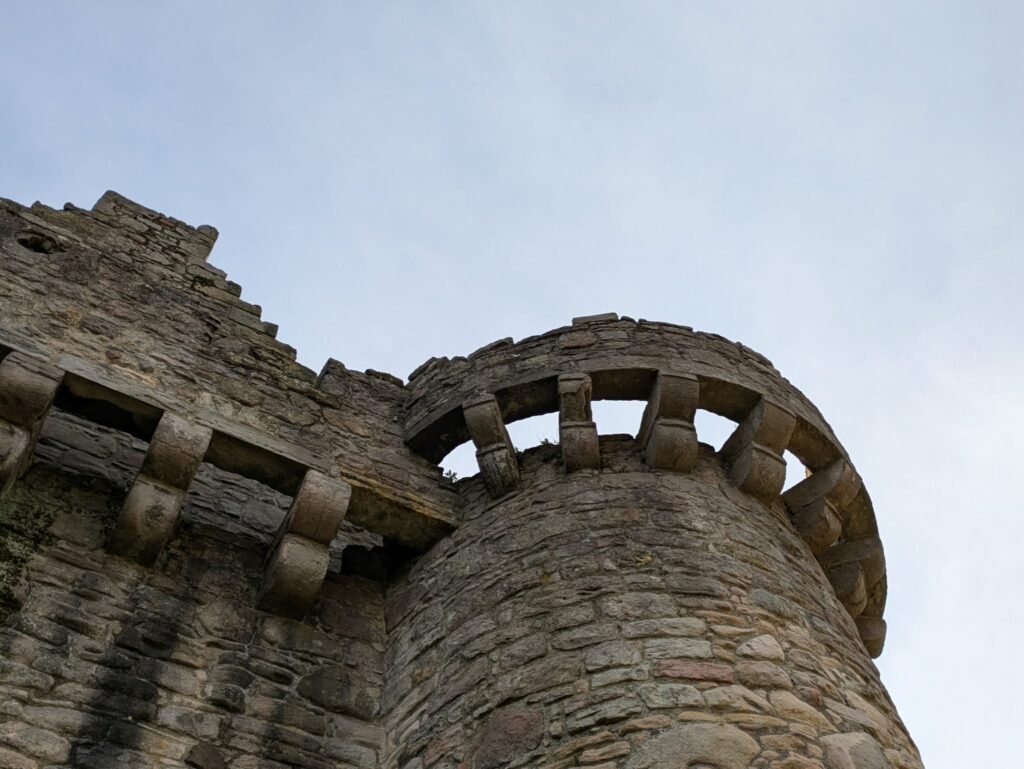
Bartizan
Bartizan is our flagship boardgame. It is a collaborative turned competitive romp with tidbits about Scottish castles to whet any would-be explorers’ appetite.
Bartizan conceptually started in December 28th 2024. Initially the idea was simple; have players build castles at the table and vie for dominance. The game then combined with a TTRPG we had had on the back burner where players’ position at the table mattered and hey presto! Bartizan was born.
If you are not interested in the history of the game, and just beautiful castles, then feel free to click through here.
The page below walks through some of the design considerations that have gone into the game and some of the philosophy behind decisions that were made along the way, now lets take a trip, you and I, down the winding road of the conception of Bartizan.

Craigmillar Castle
On December 28th 2024 Bartizan was born with this view of Craigmillar Castle. Machicolations is the word. I (Stewart) was astounded that 1) these things, that I had seen umpteen times throughout my life, either as a motif on lavish buildings or on castles in Scotland, had a concrete and fun to say name and 2) were so well designed for defence.
At the time I had been playing a castle building game on my computer (Going Medieval) and was fascinated with wanting to include machicolations in my next castle. This developed while looking at Craigmillar castle; the monogramed lake, the turrets and battlements, the gallery and courtyard. Castles had their hooks in me and I wanted to know more.
After our visit my beloved partner bought me as a gift Malcolm Hislop’s How To Read Castles book, which set the trajectory for the project. An excellent read for anybody interested. Through reading this book I came to an understanding of just how deep the castle rabbit-hole goes.
As with anything the more you go digging the more you find and soon I knew about Ravelins (wooden, rooved machicolations), Bartizans (Towers starting halfway up a wall), Battlements, not just standard battlements but Swallowtail, and Stepped Battlements, and every castle feature in between.
Once you start seeing them, you start seeing them everywhere.

Templeton Carpet Factory (Glasgow)

The Granary (Bristol)
There are two examples of Swallowtail Battlements, in Bristol and Glasgow and as you begin to see the motifs and castles’ influence on modern buildings you see them everywhere.
In Bartizan I wanted to use this also. Wingspan was a massive inspiration in this as the trivia on each card keeps players engaged while they may not have active a role in the game. Also draws the player’s eyes to the cards and will likely remind them of the game as they too see the ubiquitous architectural features on this island of birds and castles.
In line with wingspan I wanted real castles to spark the imagination of players and potentially inspire ventures into the country side to see some of the marvellous ruins in Scotland. Not all the castles I considered were used in the game, but any with potential that caught my eyes have been compiled here. Feel free to explore. Or you can read the very long list of castles here.
At the time my other main project was Nights and Noblemen which is a large TTRPG and is marred with the great pitfall of:
✨✨ B A L A N C E ✨✨
The balance of a game is incredibly important, incredibly pernickety, and incredibly laborious, and I needed a project that didn’t have this Sisyphean hill in the way. Bartizan would have a bartering, or auction system, leaning on the old adage of a free market is a fair market and, indeed the auction acts to stabilise and balance the game throughout any session.
With castles and auctions cemented into the game I was worried that the game would be too cerebral, too stuffy, and have too many optimal decisions and so pursued some chaos. In early play testing I encouraged players to invent new rules as the game progressed and the next core component of the game was born.
Monopoly home rules were now core to my game, you want to trade future stocks with your neighbour with a “I’ll do this if you do that”, that’s allowed. You want a “Give me x and I’ll make sure you get y”. Then three rounds later back-stabbing and betrayal.
Some of the early play testing games were swung one way or the other because one player broke one too many promises and the table turned against them.
A new problem began to arise
✨✨ S N O W B A L L I N G ✨✨
To those uninitiated snowballing is a common problem in competitive games that have any sort of economy. Simply put having wealth makes the acquisition of more wealth easier, and any player with an early lead cements that lead. People naturally counter snowballing in collaborative games, but Bartizan had a real problem with players accruing a lot of wealth while their neighbours were stuff in a poverty cycle.
There were two main ways to progress this, one was implementing a curve; as the game progressed the lowest level of poverty a player could be under would rise, so that a player way in the lead and the player trailing furthest in the back would not have such a large disparity. The other fix would be to penalise the ones furthest ahead.
Implementing a difficulty curve wasn’t enough and so challenges that disproportionately affected the richest player/players were introduced and this feature has been found to be effective. – Take from the rich and give to the poor.
⚠️⚠️ P A C I N G ⚠️⚠️
The current problem facing the development of Bartizan is pacing. The game lends itself to players of a particular persuasion, the types of people that want to find the optimal decision. In Bartizan the optimal decision is often tied up with other player’s decision due to the the collaborative component of the game.
Some players develop a plan in their head and then when another player does not do what was expected the game grinds to a halt while every player waits for the decision to be made.
This can be viewed positively, there is information on the cards that players can look at at their leisure during another’s turn. Players can think about how to optimally set up their board, however this does effect the feeling of the game, and can slow it down.
Often in developing this game there are a lot of things that could change, or that it would be beneficial to change, however so long as it addresses a single problem it does not get implemented.
For something to be implemented it must address two problems in the game.
We have split the advancements in the game between late game and early game, this addresses snowballing, ensuring that nobody gets too far ahead too quickly and affects pacing by ensuring that there is control on the progression of the game.
Currently the separate decks are arbitrarily split, with more complicated game mechanics being held to the advanced deck, but over time this feature will be used to address pacing too.
Finally the pacing of the game can be affected by the type of game you play. Inspired by Sail by allplay, players can begin from any level and progress from there, functionally allowing them to decide the length of game they wish to play. Playtesting will be needed to understand how long these games will take.
